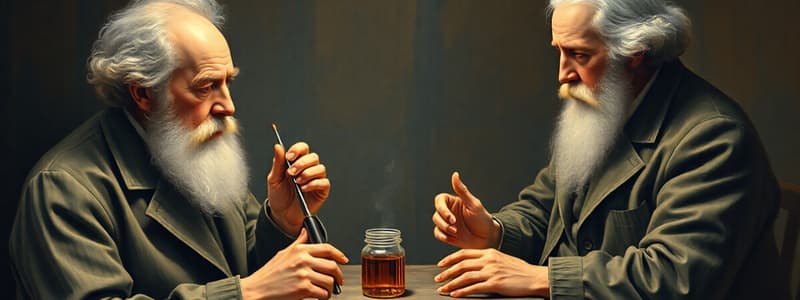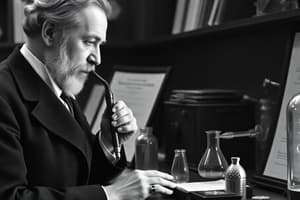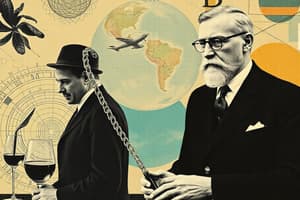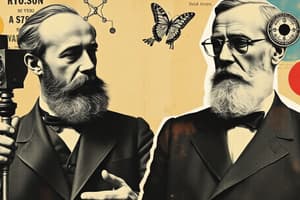Podcast
Questions and Answers
Which scientist's work significantly contributed to the development of chaos theory?
Which scientist's work significantly contributed to the development of chaos theory?
- Svante Arrhenius
- Ivan Pavlov
- Jules Henri Poincaré (correct)
- J. J. Thomson
Who developed a system for classifying stars based on their spectra?
Who developed a system for classifying stars based on their spectra?
- Srinivasa Ramanujan
- Harriet Brooks
- Annie Jump Cannon (correct)
- Henrietta Swan Leavitt
Which scientist is credited with the discovery of X-rays?
Which scientist is credited with the discovery of X-rays?
- Ivan Pavlov
- Kitasato Shibasaburo
- J. J. Thomson
- Wilhelm Conrad Röntgen (correct)
What was Ivan Pavlov's primary area of research?
What was Ivan Pavlov's primary area of research?
Which scientist developed serum therapy for tetanus?
Which scientist developed serum therapy for tetanus?
Who proposed the 'plum pudding' model of the atom?
Who proposed the 'plum pudding' model of the atom?
Which scientist linked volcanic eruptions to past ice ages?
Which scientist linked volcanic eruptions to past ice ages?
What did Henrietta Swan Leavitt's research primarily focus on?
What did Henrietta Swan Leavitt's research primarily focus on?
Who was Canada's first female nuclear physicist?
Who was Canada's first female nuclear physicist?
Which two scientists simulated early Earth conditions to study the formation of organic compounds?
Which two scientists simulated early Earth conditions to study the formation of organic compounds?
Flashcards
X-rays
X-rays
Electromagnetic rays discovered by Röntgen that pass through skin and expose photographic plates.
Classical Conditioning
Classical Conditioning
Learning process where dogs salivate at a bell sound due to Pavlov's experiments.
Serum Therapy
Serum Therapy
Medical treatment developed by Kitasato to confer immunity against diseases like tetanus.
Chaos Theory
Chaos Theory
Signup and view all the flashcards
Plum Pudding Model
Plum Pudding Model
Signup and view all the flashcards
Global Warming Hypothesis
Global Warming Hypothesis
Signup and view all the flashcards
Harvard Spectral Classification
Harvard Spectral Classification
Signup and view all the flashcards
Cepheid Variable Stars
Cepheid Variable Stars
Signup and view all the flashcards
Quantum Physics
Quantum Physics
Signup and view all the flashcards
Simulated Early Earth Conditions
Simulated Early Earth Conditions
Signup and view all the flashcards
Study Notes
19th and 20th Century Scientific Discoveries
- Science became intimately linked with progress by the turn of the 19th century
- Cutting-edge research fueled crucial shifts in fundamental ideas in the 20th century
- These shifts occurred at both subatomic and cosmological levels
Wilhelm Conrad Röntgen (1845-1923)
- German physicist who discovered X-rays in 1895
- Discovered electrically-charged vacuum tubes emitted rays that made fluorescent screens glow
- These electromagnetic rays passed through human skin, revealing underlying structures
- Awarded the first Nobel Prize in Physics in 1901
- Did not patent his discovery, instead choosing to give the prize money to scientific research
Ivan Pavlov (1849-1936)
- Russian-born physiologist, initially a religious candidate
- Became a professor at the Military Medical Academy in 1890
- Worked in the physiology department in St. Petersburg
- Research focused on digestive processes in dogs
- Discovered classical conditioning through associating a stimulus (bell) with a response (salivation)
- Awarded the Nobel Prize in Physiology or Medicine in 1904
Kitasato Shibasaburo (1853-1931)
- Japanese physician and bacteriologist
- Studied in Tokyo and Berlin
- Developed serum therapy to prevent tetanus and diphtheria
- In 1890, he identified the tetanus serum, containing the antitoxin, which protected against tetanus in animals
- Applied the same principles to combat diphtheria
Jules Henri Poincaré (1854-1912)
- French mathematical physicist known for chaos theory
- Worked on proving stability of the solar systems, noting small changes can have large effects
- Developed foundational work in chaos theory in 1908
- His insights influenced Einstein 's work on relativity
J.J. Thomson (1856-1940)
- English physicist
- One of the first to describe the structure of atoms
- Identified "corpuscles" (later electrons) using a cathode ray tube
- Determined electrons have a negative charge, 2000 times lighter than a hydrogen atom
- Developed the "plum pudding" model of the atom
- Determined the existence of isotopes: differing atom types but identical in chemical characteristics
Svante Arrhenius (1859-1927)
- Swedish physicist
- Professor of physics at the University of Uppsala
- Studied the effects of burning fossil fuels on the atmosphere
- Proposed burning fossil fuels would cause global warming, relating to modern concerns
- Contributed findings to modern climate change research
Annie Jump Cannon (1863-1941)
- American astronomer
- Leading authority on star spectra
- Classified over 350,000 stars and developed a system for spectral classification
Henrietta Swan Leavitt (1868-1921)
- Studied at Radcliffe College in Massachusetts
- Became interested in astronomy and studied thousands of stars
- Discovered a relationship between the luminosity and period of Cepheid variable stars (pulsating stars).
- Crucial to determining distances between Earth and other galaxies
- Her work not widely recognized during her lifetime
Harriet Brooks (1876-1933)
- Canadian nuclear physicist, first woman in Canada
- Worked under Thomson and Rutherford
- Discovered radioactive elements and decay methods
- Her work was often overlooked and appreciated several decades later
Srinivasa Ramanujan (1887-1920)
- Indian mathematician who made major contributions to number theory
- Largely self-taught and sent a letter of 120 complex theorems to renowned Cambridge mathematician G.H. Hardy.
- Awarded a Bachelor of Science degree and was elected a Fellow of the Royal Society.
- Became ill with tuberculosis and died young after returning to India in 1920
Erwin Schrödinger (1887-1961)
- Austrian physicist who studied quantum mechanics and wave mechanics
- Developed the Schrödinger equation, a key equation in quantum mechanics revolutionising the understanding of atomic structure
- Contributed to the concepts of quantum wave equation through modelling orbiting electrons as "clouds"
- Explained concepts in quantum mechanics through orbitals, clouds and subshells
Ronald Fisher (1890-1962)
- British statistician and geneticist
- Applied statistics to scientific experimentation, particularly in evolutionary biology
- Reconciled Charles Darwin's ideas of natural selection with the recently discovered experiments of Gregor Mendel
- Was knighted in 1952
Harold Urey and Stanley Miller (1893-1981; 1930-2007)
- American chemists.
- Simulated early Earth's conditions in the laboratory to understand the origin of organic compounds
- Used flasks and gases such as water, methane, and ammonia to demonstrate conditions favourable for the creation of amino acids
- Showed how building blocks of proteins could arise from the mix of simple gases
Studying That Suits You
Use AI to generate personalized quizzes and flashcards to suit your learning preferences.





